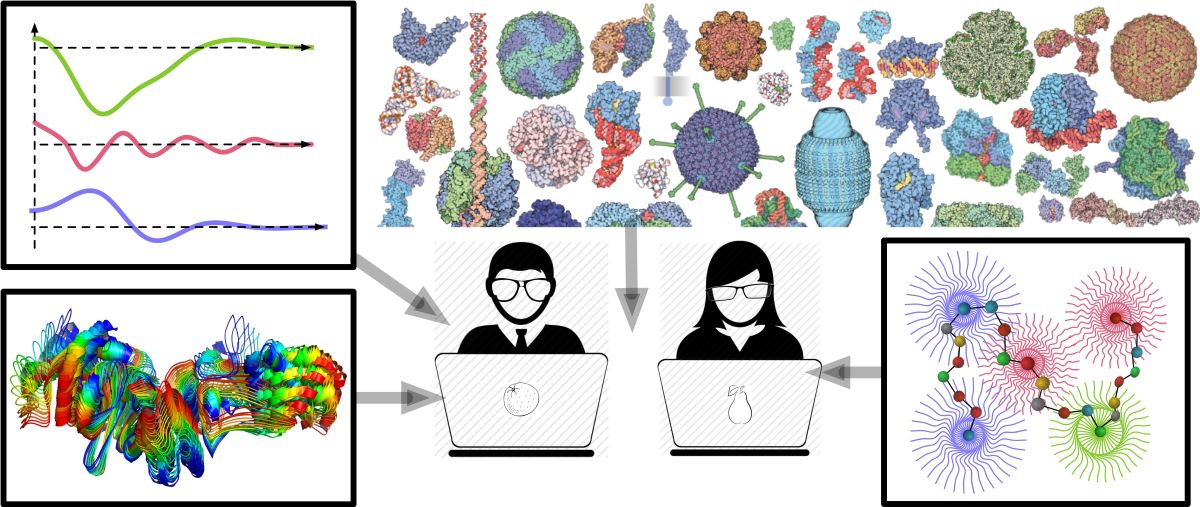Our group, Kiharalab, participated in both the prediction and scoring stages for complex targets. We combined three components in our pipeline, DistPepFold [1], AFSample [2], and a consensus-based score called ranksum we developed for our LZerD protein docking program [3]. For peptide docking, we used our new approach, DistPepFold. DistPepFold improves protein-peptide complex docking using an...
We have participated, both as predictors and as scorers, in all proposed targets of the 8th CAPRI edition. Here we will focus on the 11 purely CAPRI targets, that is, excluding the CASP-CAPRI joint rounds 46, 50 and 54, already evaluated and discussed in the respective CASP meetings, and the 4 targets in round 51 related to COVID19, with no available structure for evaluation. These 11 targets...
In the latest CAPRI round our group used a combination of Alphafold-Multimer (AFM), the ClusPro webserver for docking, and Molecular Dynamics based sampling to refine models for small targets. Assembly prediction was based on a two-stage methodology, in which we first generate an ensemble of initial models using AlphaFold-Multimer using standard protocol for MSA generation. We stop the...
Massive sampling with AlphaFold-multimer(1,2) showed impressive results for structural prediction of macromolecular assemblies at CASP15-CAPRI(3). Generating a very large number of predictions (>1000) and pushing their diversity by playing with the neural network model versions, the number of recycle steps, the use of templates or not and the activation of the dropout in the Evoformer and in...
In the field of structural biology, predicting protein interactions and designing sequences based on backbone scaffolds remain pivotal yet challenging tasks. Built on the same deep learning architectural framework, Protein Structure Transformer (PeSTo) and its derivative, CARBonAra, address these challenges. PeSTo employs geometric transformers to proficiently predict diverse protein binding...
In CASP15, 87 predictors submitted around 11,000 models on 41 assembly targets. The community demonstrated exceptional performance in overall fold and interface contact prediction, achieving an impressive success rate of 90% (compared to 31% in CASP14). This remarkable accomplishment is largely due to the incorporation of DeepMind’s AF2-Multimer approach into custom-built prediction pipelines....
Since the last CAPRI meeting, much has happened in the modeling field. Deep Learning (DL) has revolutionized structure prediction, and we are only beginning to grasp the fruits, as well as the new challenges uncovered in this new era.
I will describe different approaches that we developed and applied to address CAPRI challenges, and how they helped us shape and improve our ability to model,...
The HADDOCK team have participated as human and webserver predictor and/or scorer in last CAPRI rounds (47-55), mainly relying on the use of our integrative modelling software HADDOCK[1] which is able to use user-provided information to guide the docking process. An important element of HADDOCK is its scoring function, computed from the weighted sum of 4 energetical terms (VdW, Electrostatics,...
Protein-RNA interactions and recognition are essential in gene expression, regulation of transcription, and other biological processes. Prediction of protein and RNA is also a new challenge category for CAPRI and CASP. In this work, we proposed a multistage docking protocol called CoDockPR, which integrates the shape complementarity, knowledge-based scoring functions, and interface similarity...
Protein-DNA interactions play a significant role in biological processes and drug design owing to their prevalence. Computational methods for predicting protein-DNA complex structures serve as a valuable alternative to experimental methods, which, although more accurate, are also time-consuming and resource-intensive. The established framework for predicting protein-protein complex structures...
Understanding the functions of protein-protein and protein-nucleic acid complexes relies on the knowledge of their 3D structures that can either be solved experimentally or predicted computationally. While AlphaFold has revolutionized protein structure prediction, challenges remain, particularly in modeling antibody-antigen interactions, protein-nucleic acid complexes, and proteins lacking...
In this talk I will introduce our recent works on machine learning for protein-ligand interactions, including explainable prediction of protein-ligand binding affinity and structure-based de novo ligand design.
First, as deep learning methods for modeling protein-ligand interactions are increasingly improving their accuracy, their interpretability is often under-explored. We had...
Macromolecular complexes play a crucial role in almost all biological functions in living cells. Elucidating structural features in proteins is essential to understanding their underlying functions and binding activity. With the rapid accumulation of protein-structure data through AI methods and experimental techniques, such as cryo-electron microscopy, there is a growing demand for efficient...
Rotary ATP synthases are large enzyme complexes present in every living cell. They consist of a transmembrane and a soluble domain, each comprising multiple subunits. The transmembrane part contains an oligomeric rotor ring (c-ring), whose stoichiometry defines the ratio between the number of synthesized ATP molecules and the number of ions transported through the membrane. Here, we present...
The understanding of biochemical processes and the machinery of life hinges on comprehending the structural aspects of macromolecular interactions. This requires a systematic approach to analysing the vast manifold of macromolecular associations, or complexes, typically determined from crystallographic or electron microscopy experiments. Specific points of interest include similarity...
The Pierce group has utilized a combination of AlphaFold and traditional docking methods, including Rosetta and ZDOCK, to model protein complexes in recent CAPRI and CASP/CAPRI rounds. This has led to success for several challenging targets, as well as useful lessons learned for prospective modeling efforts. Our group has been particularly focused on the utilization and adaptation of AlphaFold...

